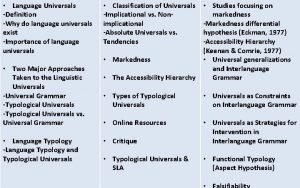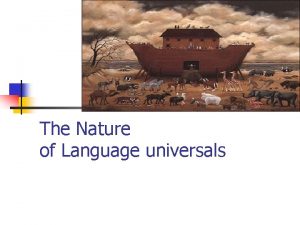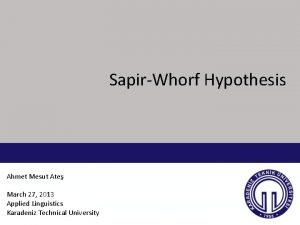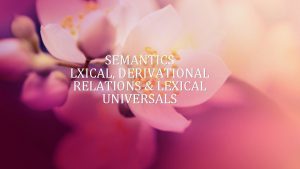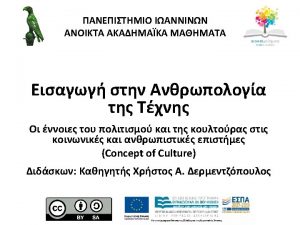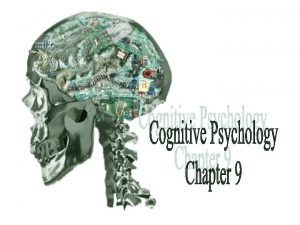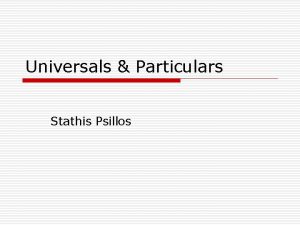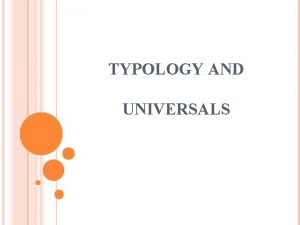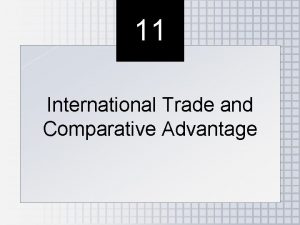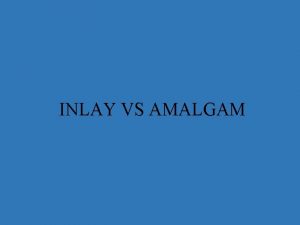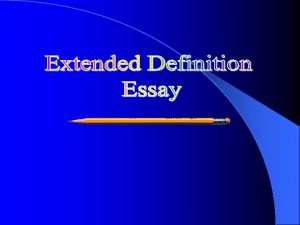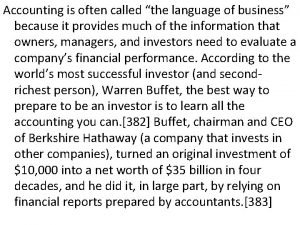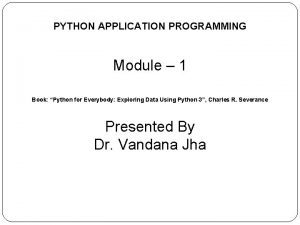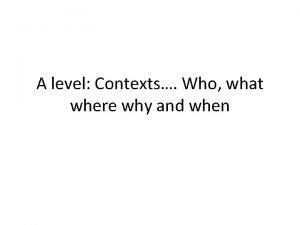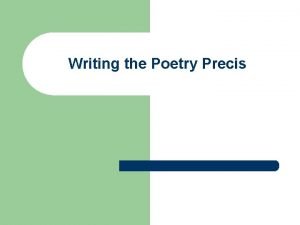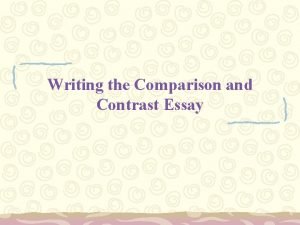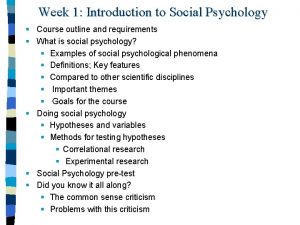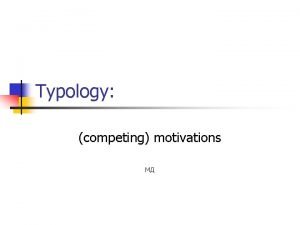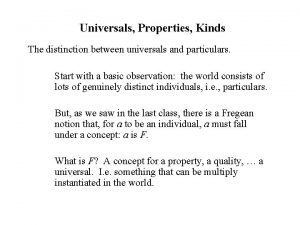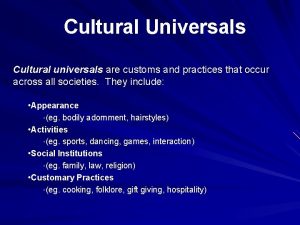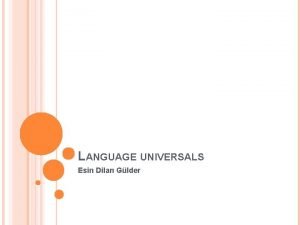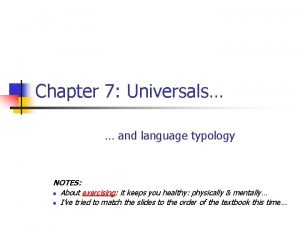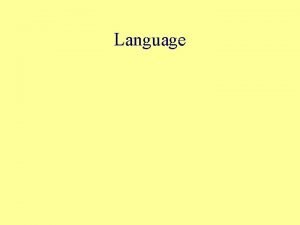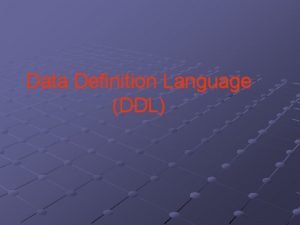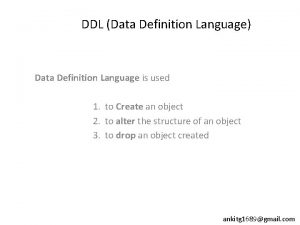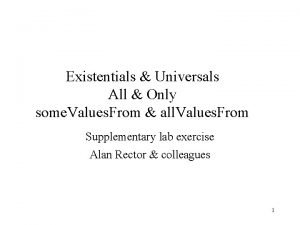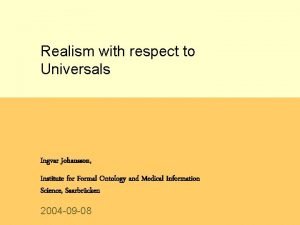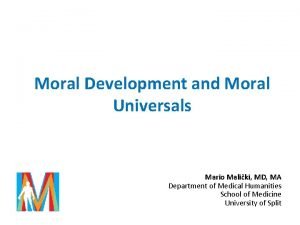OUTLINE Language Universals Definition Why do language universals



































- Slides: 35

• OUTLINE Language Universals -Definition -Why do language universals exist -Importance of language universals • Two Major Approaches Taken to the Linguistic Universals -Universal Grammar -Typological Universals vs. Universal Grammar • Language Typology -Language Typology and Typological Universals • Classification of Universals -Implicational vs. Nonimplicational -Absolute Universals vs. OUTLINE Tendencies • The Accessibility Hierarchy • Studies focusing on markedness -Markedness differential hypothesis (Eckman, 1977) -Accessibility Hierarchy (Keenan & Comrie, 1977) • Universal generalizations and Interlanguage Grammar • Types of Typological Universals • Universals as Constraints on Interlanguage Grammar • Online Resources • Critique • Universals as Strategies for Intervention in Interlanguage Grammar • Typological Universals & SLA • Functional Typology (Aspect Hypothesis) • Markedness


Definition of Language Universals statements of what is possible and impossible in languages (Finegan, 2011). LANGUAGE UNIVERSALS What is common to all languages (Mc Laughlin, 1989)

Why do language universals exist? Original Language Hypothesis v all of the languages in the world derive historically from the same language Universals and Perception v languages are symptoms of how all humans perceive the world and conduct verbal interactions Acquisition and Processing Explanations v psychological explanations that have no physical basis. Social Explanations v basis on cognition and others reflect the fact that language is a social tool. Finegan, 2011

Importance of Language Universals state what is possible in human language and what is not. They help us to understand brain and principles that govern interpersonal communication in all cultures. They help us to understand what in the human brain and social organization of everyday life enables people to communicate through language. Finegan, 2011

Two Major Approaches Taken to the Linguistic Universals n o i t ra em m s i l a piri Noam Chomsky Joseph H. Greenberg cism

LANGUAGE TYPOLOGY VS. UNIVERSAL GRAMMAR Universal Grammar Language Typology v. Theory driven v. Data driven v. Abstract principles that apply to v. Less abstract all languages v. Generally derived by deduction v. In-depth analysis of the properties of a language v. Based on readily observable data v. Examination of the surface features of a wide range of languages (Van Patten & Benati, 2010; Mc. Laughlin, 1989)

LANGUAGE TYPOLOGY Greenberg and his followers analyzing data from a representative sample of world’s languages in order to extract universal patternings To what extent different languages are structured according to universal principles (Mc. Laughlin, 1989, p. 83)

LANGUAGE TYPOLOGY The study of patterns exhibited in languages worldwide (Gass & Selinker, 2008) A field of study in which patterns that exist among the languages of the world are researched and the possible variation found in human languages described (Mc. Laughlin, 1989) The specification of language universals based on discerned patterns The limits define the universals

LANGUAGE UNIVERSALS AND LANGUAGE TYPOLOGY Language universals What is common to all languages Complementary to each other Language typology Variation that exists between languages

LANGUAGE TYPOLOGY «In developing a typology, researchers examine actual representations of a particular parameter to determine whether the various logical possibilities are found across languages. » (Mc. Laughlin, 1989, p. 83)

: Universal O S V h t i w s language rder o d r o w c i bas ns o i t i s o p e r have p 74) 9 1 , g r e b (Green 1. 2. 3. 4. VSO with prepositions VSO without prepositions Non-VSO without prepositions

CLASSIFICATION OF UNIVERSALS (Mc. Laughlin, 1989; Comrie, 1981 as cited in Mc. Laughlin, 1989) Typological Universals Based on the presence of property Nonimplicational universals Implicational universals Based on exceptions Absolute universals Tendencies

Non-implicational vs. Implicational Universals Nonimplicational Present or absent in natural languages without reference to any other properties of the given langauge Languages have vowels (Mc Laughlin, 1989, p. 84)

Non-implicational vs. Implicational Universals implicational Relate the presence of one property to the presence of some other property In languages with prepositions, the genitive almost always follows the governing noun, while in languages with postpositions it almost always precedes nouns (Greenberg, 1963, p. 78)

Absolute Universals vs. Tendencies Absolute Universals without exceptions Tendencies with exceptions

Absolute Universals vs. Tendencies Absolute universal/ Tendency Non-implicational/ Implicational Absolute Non-implicational Tendency (some Salishan languages) Non-implicational If a language has a VSO as its basic word order, it has prepositions. Absolute Implicational If a language has SOV basic word order, it will have postpositions. Tendency (Persian is SOV with prepositions) Implicational All languages have vowels. All languages have nasal consonants. Mc. Laughlin, 1989

Markedness v. An observation of the implicational relationship between categories (Mc Laughlin, 1989) v A linguistic concept related to how common or typical a feature is (Van Patten & Benati, 2010)

Markedness Implicational Relationships A B A is more marked than B HOWEVER However, it is not possible to define typological markedness on the basis of implicational relationships, because there are no two categories, A and B, that co-exist in the language and have an implicational relationship. In such cases, markedness is based on frequency (Mc. Laughlin, 1989).

Markedness Something that is more common or ubiquitous is considered less marked or unmarked, while something less common or less natural is considered marked or more marked. Markedness can be used to make Something unmarked crosslinguistic or less marked may comparisons (what be considered as the happens around the default form of the world with feature (Van Patten & languages) or what Benati, 2010). happens within a single language

Markedness Tom is the man who studies SLA. Relative clause

Markedness v Subject relative clause: Tom is the man who studied SLA v Object relative clause: SLA is the subject that Tom studied v Indirect object relative clause: Tom is the guy who I gave the SLA book to v Object of preposition clause: Tom is the guy who I studied SLA with v Genitive clause: Tom is the guy whose SLA book I borrowed v Object of comparison clause: Tom is the guy who I am taller than M o r e m a r k e d

Markedness • Markedness has been shown to be relevant to both L 1 and L 2 acquisition.

The Accessibility Hierarchy • Keenan and Comrie (1977) • An example of chain of implicational universals: if a language can relativize on position n, then necessarily it can also relativize on position n-1 Mc. Laughlin, 1989

The Accessibility Hierarchy 1. If a language can relativize on a given preposition on the Accessibility Hierarchy, then it must be able to relativize on all positions higher on the hierarchy, because a position lower on the hierarchy cannot be more accessible then one higher. 2. For each position on the Accessibility Hierarchy, there is some possible human language that can relativize on that position but on no lower position, because each position on the hierarchy is thought to define a potential cut-off point. Mc. Laughlin, 1989

The Accessibility Hierarchy • The Accessibility Hierarchy attempts to characterize the various types of relative clause construction among different languages. • Researchers have argued that the construction of a noun phrase for relativization depends on its grammatical role. Van Patten & Benati, 2010

The Accessibility Hierarchy Van Patten & Benati, 2010

TYPES OF TYPOLOGICAL UNIVERSALS Word order typology Transivity typology Syntactic typology Word classes Voice typology Morphological typology Case-marking typology Grammatical relations typology Semantic typology Person marking Typology of tense, aspect and modality systems Typology of phonological systems Song, 2013

Word order typology In languages with prepositions, the genitive almost always follows the governing noun, while in languages with postpositions it almost always precedes noun (Greenberg, 1963)

Word order typology • The leg of the table • My friend’s dog Preposition follow the noun Possessed precedes possessor IMPLICATIONAL TENDENCY

Word order typology • Languages with dominant verb-subject-object (VSO) order are always prepositional (Greenberg, 1963) Implicational absolute universal

Online Sources • World Atlas of Language Structures http: //wals. info/ • The Language Index https: //languageindex. online. unimarburg. de/

CRITIQUE • Wide range of languages • Representative sample of human languages -> how is one to know that the sample is sufficiently large and varied to include examples of all the kinds of structures found in human languages?

• Even if the sample could be shown to be representative, there remains the problem of demonstrating the empirical validity of putative linguistic universals • The Notion of tendency

• It is undeniable that typology has been able to produce theoretical tools in the form of implicational generalizations, which provide hypotheses for the description of learner languages (Ramat, 2009)
 Universals in language
Universals in language Pictures
Pictures Joseph cristofaro
Joseph cristofaro Linguistic universals
Linguistic universals Dont ask why why why
Dont ask why why why Evidence sandwich example
Evidence sandwich example Hrm jobs list
Hrm jobs list Meronymy
Meronymy Cultural universals
Cultural universals Cultural universals
Cultural universals Language
Language Particulars and universals
Particulars and universals Typology and universals
Typology and universals Outline why
Outline why Why-why analysis
Why-why analysis Why do you cry, willie
Why do you cry, willie Does the table represent a function why or why not
Does the table represent a function why or why not What does the image represent
What does the image represent Why or why not
Why or why not Metode analisis akar masalah dan solusi
Metode analisis akar masalah dan solusi Dental inlay definition
Dental inlay definition How to write a good definition essay
How to write a good definition essay Basic knowledge of english
Basic knowledge of english Why english is international language
Why english is international language Who said accounting is the language of business
Who said accounting is the language of business Btechsmartclass.com
Btechsmartclass.com Why the english language is so hard
Why the english language is so hard Why drawing was identified as the language of industry
Why drawing was identified as the language of industry Why python is high level language
Why python is high level language Why was french the language spoken in valmonde
Why was french the language spoken in valmonde Precis example
Precis example Leq definition ap
Leq definition ap Comparison and contrast outline
Comparison and contrast outline Social psychology course outline
Social psychology course outline Lesson outline lesson 3 describing circuits answers
Lesson outline lesson 3 describing circuits answers What are protists lesson outline
What are protists lesson outline
